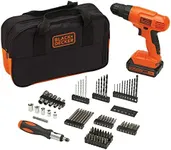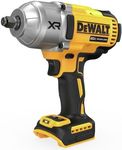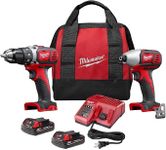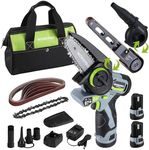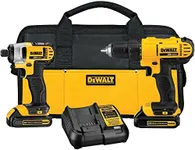Buying Guide for the Best Impact Drills
When choosing an impact drill, it's important to consider your specific needs and the types of projects you'll be working on. Impact drills are versatile tools that can handle a variety of tasks, from driving screws to drilling into tough materials like concrete and metal. Understanding the key specifications will help you select the best impact drill for your requirements, ensuring efficiency and ease of use in your projects.Power (Voltage)The power of an impact drill is typically measured in volts (V). This spec indicates the drill's ability to handle tough materials and heavy-duty tasks. Lower voltage drills (12V-18V) are suitable for light to medium tasks, such as driving screws and drilling into wood. Higher voltage drills (20V and above) are designed for more demanding jobs, like drilling into concrete or metal. Choose a voltage based on the intensity and frequency of your projects.
TorqueTorque is the rotational force that the drill can apply, measured in inch-pounds (in-lbs) or Newton-meters (Nm). Higher torque means the drill can handle tougher materials and larger screws. For light tasks, such as assembling furniture, a lower torque (up to 300 in-lbs) is sufficient. For more demanding tasks, like construction or automotive work, look for higher torque (300 in-lbs and above). Match the torque to the toughest material you expect to work with.
Speed (RPM)Speed, measured in revolutions per minute (RPM), indicates how fast the drill bit rotates. Impact drills often have variable speed settings, allowing you to adjust the speed based on the task. Lower speeds (0-500 RPM) are ideal for driving screws, while higher speeds (up to 3000 RPM) are better for drilling. Consider a drill with multiple speed settings if you need versatility for different tasks.
Battery LifeBattery life is crucial for cordless impact drills, as it determines how long you can work without recharging. Look for drills with high-capacity batteries (measured in ampere-hours, Ah) for longer runtime. For occasional use, a 1.5-2.0 Ah battery may suffice. For frequent or heavy-duty use, consider batteries with 3.0 Ah or more. Also, check if the drill comes with spare batteries or a fast charger to minimize downtime.
Weight and ErgonomicsThe weight and design of the impact drill affect comfort and ease of use, especially during extended periods. Lighter drills (under 3 pounds) are easier to handle and reduce fatigue, making them suitable for overhead or prolonged tasks. Heavier drills (over 3 pounds) may offer more power but can be tiring to use. Ergonomic features like a comfortable grip, balanced weight distribution, and anti-vibration technology can enhance user experience. Choose a drill that feels comfortable and manageable for your typical projects.
Chuck SizeThe chuck size determines the maximum diameter of the drill bit that the drill can accommodate. Common sizes are 1/4 inch, 3/8 inch, and 1/2 inch. Smaller chucks (1/4 inch) are suitable for light-duty tasks and smaller bits, while larger chucks (1/2 inch) can handle bigger bits for heavy-duty drilling. Consider the types of bits you plan to use and choose a chuck size that matches your needs.
Additional FeaturesAdditional features can enhance the functionality and convenience of an impact drill. Look for features like LED lights for better visibility in dark areas, brushless motors for increased efficiency and longevity, and adjustable clutch settings for better control over torque. Some drills also offer built-in storage for bits and accessories. Consider which features will be most beneficial for your specific tasks and preferences.
